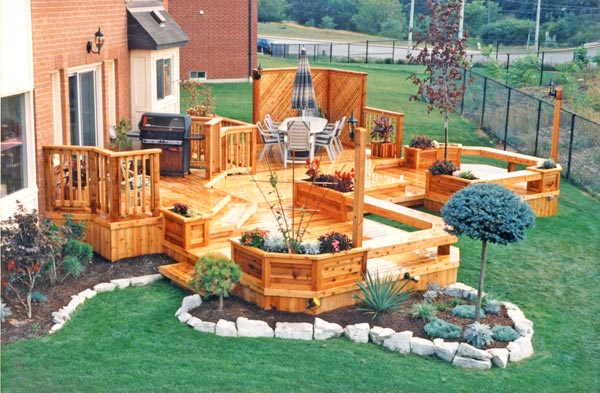
 You’ve finally decided to build the deck you’ve been thinking about, but there are so many material options. How do you go about choosing the deck construction material that’s right for you? Appearance, durability, resistance to bugs and mold, scratch resistance, exposure to direct sun, and frequency of maintenance are all things you should consider.
You’ve finally decided to build the deck you’ve been thinking about, but there are so many material options. How do you go about choosing the deck construction material that’s right for you? Appearance, durability, resistance to bugs and mold, scratch resistance, exposure to direct sun, and frequency of maintenance are all things you should consider.
Paradise Decks and Landscape Design offer a wide selection of deck construction materials to choose from, including pressure treated pine, cedar, several different types of composite and PVC products, ipe, tigerwood and teak. In this guide we’ll look at the differences between different types of deck construction materials and help you choose the one that’s right for you.
Cost
Price will influence your choice of deck construction materials, so think about a budget. Pressure treated pine will be your lowest cost option. From there, cedar will be your next most affordable option, followed by composite materials and then PVC (100% plastic). Exotic hardwoods such as ipe, tigerwood, and teak represent the upper price range of deck construction materials.
Appearance
Will your deck be strictly functional? Or should the appearance of your deck resonate with you on an emotional level and create feelings of warmth, well being, and beauty? Perhaps you’re looking for a reasonable compromise between the two.
One of the first things you’re going to have to decide is how important it is for your deck to look like wood. Properly finished natural wood can evoke feelings of warmth and beauty — just sitting on your natural wooden deck can improve your mood. Synthetic products can be used to create more modern-looking low maintenance decks with some manufacturers using shade variations and embossed grain patterns to achieve a more natural appearance. Which style do you favour?
Wood vs. Synthetic — Durability And Maintenance
Aesthetic considerations aside, all wooden decks require maintenance, while PVC and composite decks are designed to require very little. If you choose wood you must be prepared to commit to a regular maintenance schedule. Factors such as the amount of sun exposure or shade, average climate, proximity to water, elevation from grade or even what type of trees surround the deck will all be important considerations when choosing building materials. For example, PVC decking is 100% plastic and composite decking contains both plastic and wood fiber.
A dark shade of composite or PVC decking can become quite hot on a sunny July day. Wood tends to be cooler however even wood treated with a dark stain can become quite hot when exposed to direct sunlight.
Because of the plastic content, PVC and composite decks will not warp, splinter, or rot, while wooden decks must be regularly maintained to prevent this. PVC and composite decks are highly resistant to insects but have low to medium resistance to scratches. Due to the plastic content in PVC and composites, scratches cannot be sanded out but that same plastic means they will not produce splinters.
Hard wood is highly resistant to scratches, while soft wood has lower scratch resistance. Scratches can be sanded out of both hard and soft wood. Hard wood is more resistant to insects than soft wood in general, but certain kinds of soft wood such as cedar are naturally resistant to insects. Soft wood is more susceptible to producing splinters than hard wood, but regular maintenance will minimize the problem for both types.
The Difference Between Composite and PVC Decking
The main difference between composite and PVC construction materials is that PVC is 100% plastic, while composite decking is a blend of wood fibers and plastic. Some types of composite decking can better approximate the appearance of natural wood because of the fiber content while all plastic products have more difficulty achieving this look.
Some types of composite material may be formulated to look like wood, but may have a cheap plastic appearance. Composite decking may also contain waxes, fiberglass, and preservatives, while PVC is 100% plastic. Composite is the least expensive type of synthetic material because it contains less plastic and costs less to manufacture. Both composite and PVC deck construction materials come in a wide range of colour choices.
Make Your Choice
Once your budget is set have an honest conversation with yourself. If you build a natural wooden deck, are you the type of person that can commit to regular maintenance? If not, would you be prepared to hire out this job? If the answer to both these questions is no, composite or PVC decking materials might be better choices for you. While the initial construction costs for composite and PVC decks are higher than those for pressure treated pine, the ongoing maintenance costs are significantly lower.
Finally, think about the how you will most likely use your deck and how you want it to make you feel. Close your eyes and picture yourself on your deck. Are you imagining a more natural, quiet, cottage-like setting that brings you closer to nature or a sleeker, contemporary, functional space? Answering these questions will help you decide which deck construction materials are right for you.






